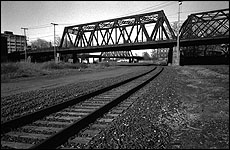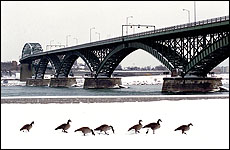Archives
Bridges frame views of Buffalo
Exhibition of 38 photographs by Bruce Jackson on display in historical society
By KEVIN FRYLING
Reporter Contributor
Most people don't notice a bridge unless it's particularly ugly or clogged with traffic, says UB faculty member Bruce Jackson.

"Bridges are perhaps the most invisible form of public architecture," says Jackson, SUNY Distinguished Professor and Samuel P. Capen Professor of American Culture in the departments of American Studies and English.
Bridges are, in fact, open-air structures that drivers and pedestrians frequently inhabit—if but briefly, he says. "Bridges become frames for looking at the world around us," says Jackson.

Bruce Jackson, whose photographs
of Buffalo bridges are on display in the Buffalo and Erie County
Historical Society, calls bridges "the most invisible form of
public architecture." Bridges, he says, "become frames for
looking at the world around us."
PHOTOS: BRUCE JACKSON
"Bridging Buffalo," an exhibit featuring photographs taken by Jackson of bridges throughout Buffalo, opened yesterday in the Buffalo and Erie County Historical Society. It will be on display through Jan. 27, 2007.
Most of the 38 photographs in the exhibit were taken in the 1990s and 2000s. Jackson says one of the panoramic shots was taken more than 30 years ago and he has only recently been able to develop it due to advances in digital technology.
Jackson's photographs put the spotlight on bridges—often-overlooked "sculptural objects" that, nonetheless, have the power to affect people's perceptions about the landscape around them, he says.
This idea of bridges as frames for viewing the world comes through in photos that view Buffalo landmarks from local bridges. Among them are shots of the Niagara River and downtown Buffalo as seen from the Peace Bridge.
In fact, the exhibit highlights the Peace Bridge with additional artifacts drawn from the historical society that are related to the construction of the 5,800-foot span, says Behroo Khodadad, who prepared the exhibit for the historical society. Among the artifacts on display are a ceremonial shovel that was used to break ground on the bridge and a ticket, program and invitation from the bridge dedication in 1927.
There is heightened focus on the Peace Bridge now because of the decades-long project to build a second bridge connecting Buffalo to Canada across the Niagara River and Black Rock Canal.
Photos in the exhibit highlight the unusual construction of the bridge, notes Jackson, who has written a series of articles on the Peace Bridge in the local alternative newspaper Artvoice.
"The Peace Bridge is much more attractive on the Canadian side than the American side," he explains. The four "graceful" arches across the Niagara contrast with the "ungainly" suspension portion over the canal, which he says, was included in the bridge design to accommodate the U.S. Coast Guard's insistence on a 100-foot clearance on the American side.
He says the design of the second bridge is expected to mirror the first due to this requirement, although, Jackson points out, no ship with a 100-foot mast is known to have ever traveled down the Black Rock Canal.
Although the focus of the exhibit is on bridges, the photographs also draw attention to wider issues of politics and preservation—contrasting the past and present—as well as raise questions about the future of Buffalo.
One of the three impressive panoramic photos in the display features a view of the Skyway, photographed by Jackson in 1975, at the point where the Amtrak railroad tracks curve under the bridge. This photo, which reveals the poor condition of the Skyway before it underwent repair, is contrasted with shots taken during the past few years that show the bridge in an improved condition.
Featured as well are before-and-after views of bridges on Seneca and Hamburg streets in the Hydraulics neighborhood just east of downtown where Jackson lived in the 1990s. The photos show that a complex group of steel truss bridges have been replaced with pre-fabricated concrete models.
Jackson adds that this neighborhood was once home to Frank Lloyd Wright's Larkin Administration Building, which also has been destroyed.
Jackson points out that bridges often are considered permanent structures because they appear so solid, but they actually are very ephemeral. One photograph Jackson says he wishes he had taken is of a beautiful winding bridge along the S-curve on Delaware Avenue in Delaware Park that was demolished when the road was repaired years ago and replaced with a straight concrete bridge.
Jackson currently lives near Delaware Park, and the exhibit features photos of the Twirly Pedestrian Bridge and Stone Bridge, both in the park.
The exhibition also includes a photo of the city's historic waterfront H-O Oats grain elevators as seen from the South Michigan Street drawbridge. The center of a controversy among preservationists, Jackson says wrecking equipment from the Seneca Indian casino project is visible in the picture.
Khodadad says the exhibit includes comments from Jackson providing perspective on his photographs. She adds that the historical society also plans a gallery tour, at which Jackson is expected to speak.
"Bridging Buffalo" is located in the main room of the historical society at 25 Nottingham Court at Elmwood Avenue.
